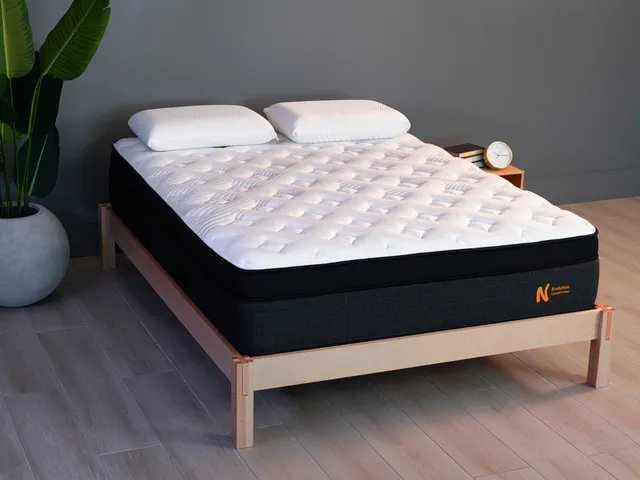This is especially applicable for areas where body weight is centralized when you’re lying down, particularly around the hips and shoulders. Pocketed coils are also meant to outperform traditional ones in the motion isolation arena, meaning that when you move around, the individual coil takes the heat motion-wise and stops the bed from reenacting a small earthquake. With the interconnectivity of traditional coils, it doesn’t take much for the feeling of movement to travel along the entire surface of the bed.
Fun fact: You do not need a box spring with a hybrid mattress. This is a recurring question I see, and pocketed coils in hybrids eliminate the need for one. Box springs were designed to give more support and elevate performance to traditional coil beds, which would align certain sections of coils to yield more support. Nowadays, you may actually void your warranty if you use a box spring with a hybrid mattress—be sure to check that fine print.
The Nolah Evolution seamlessly puts together some superb memory foam and pocketed coils, both of which counteract tension buildup for pressure points. I love it as an option for side sleepers for this reason, but it also works for back and stomach sleepers too. The coils also make it easy to move around on, which is helpful for co-sleepers.
Another solid hybrid we’ve tested is the Helix Midnight Luxe, which happens to be our top overall pick in our best mattresses guide. It also utilizes pressure-relieving foams and pocketed coils to provide targeted lumbar support.
Memory Foam
We actually have NASA to thank for this one. If you google images of those early space missions, it’s no wonder that something was needed to keep astronauts from being jostled around inside rockets; hence, memory foam was born. It’s evolved quite a bit from those initial iterations, especially when Tempur-Pedic came onto the scene in the ’80s with a vision for it to become the basis of sleep products. Today, memory foam stands in a league of its own when it comes to the unique, compressive feel.
Memory foam is more of an umbrella term for all the iterations mattress brands have come up with today, but let’s refer to the mattress manufacturing expert for this one.
“Memory foam is produced by combining liquid polyurethane with various chemicals, like polyols and isocyanates, to enhance its viscosity and density,” says Merwin. Without whipping out the periodic table of elements and giving you a science lesson in the chemical components of this material, here’s the need-to-know: These compounds form a malleable foam that holds teeny-tiny bubbles within it. How it works is, as you lie on it, your body imparts heat onto the surface, flowing into these air pockets, which in turn allows it to become softer to contour around your body.
But for the science enthusiasts reading this, Merwin’s got you covered: “The key ingredient is a polymer that creates an open-cell structure, which allows the material to respond to heat and pressure. This is what gives memory foam its signature contouring or ‘hugging’ feel. During the manufacturing process, the liquid foam mixture is poured onto a moving line, where it expands and solidifies into large foam blocks, which we call ‘buns.’ At a high level, it’s a blend of chemistry and precision that transforms raw materials into a high-quality product.”
To say it’s a natural fit for those who need pressure relief from their mattress may be a bit too on the nose, but it’s arguably the most standout feature of this material. It also lessens the feeling of movement for the most restless of sleepers, which also makes it an attractive option for couples. Arguably, the biggest issue that plagues memory foam is heat retention, since once the heat has entered into these air chambers, it turns into something akin to microscopic saunas that can make the overall mattress into a nightmare for those who sleep warm. This is where the various iterations of foam come into play, as some brands infuse elements like graphite, copper, gel, or more advanced cooling technology like phase-change materials into the foams that they use.
Three layers of foam make up the Bear Original, but its certifications and cooling cover are here to help dispel any rumors that circulate about the downsides of memory foam. You won’t find any eyebrow-raising chemicals here thanks to CertiPur-US and GreenGuard Gold certifications. Plus, you can add on a Celliant cover for a cooled-down feel.
The Nectar Premier is another memory foam option we’ve tested and liked, especially for side sleepers. Its foam layers are stacked so that you feel more pressure relief on top, but get more than enough support via a firmer foam layer at the bottom.
Latex
The same stuff that goes into tires, balloons, and sports equipment can also be used for mattresses—and it’s the good stuff, too. Latex acts similarly to memory foam when it comes to pressure relief, but is far more reactive to you moving around. Think of a rubber band snapping back into shape when released; it’s pretty dang close to that. Many brands rely on organic rubber sap to create latex as we know it, and there are two categories of latex foam you’ll usually find with mattresses: Dunlop and Talalay. These names refer to the production process and resulting product, as liquid rubber is poured into molds, torched at high temperatures (called “vulcanization” and yes, I have to resist doing Spock’s “live long and prosper” hand signal every time), and flash-frozen to retain the feel. Dunlop is a firmer latex foam, and hence, firmer feel. Talalay yields a more plush feel. Latex is generally pretty even-keeled when it comes to temperature, too, keeping heat from accumulating within your mattress to maintain a nice, room-temperature feel.
WIRED reviewer Scott Gilbertson has applauded the organic latex construction of the Birch Luxe Natural, citing great support for the lower back region and good temperature regulation.
Smart Mattresses/Adjustable Beds
The mechanics behind smart or adjustable mattresses involve air chambers that can inflate or deflate on command, letting you adjust your firmness level via controller or remote control (depending on the model or brand).
Features can vary among brands, especially depending on whether you opt for the brand’s base as well. By itself, a smart mattress can go firmer or softer at the touch of a button, and some models may be composed exclusively of foam layers over an air-chamber core. In the case of the Sleep Number P6 mattress, which I happen to be testing at the moment, there are zoned mini air chambers beneath the cover that instantly respond to high-pressure areas and adjust support levels accordingly.







